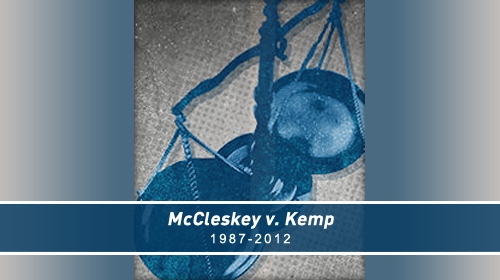VICTORY! North Carolina Judge Finds Intentional Racial Discrimination in Death Penalty System


April 22 marks the 25th anniversary of the Supreme Court decision in McCleskey v. Kemp, in which the Court ruled that a defendant cannot rely upon statistical evidence of systemic racial bias to prove his death sentence unconstitutional, no matter how strong that evidence may be. McCleskey has been roundly condemned as a low point in the quest for equality that begs to be revisited. To mark the occasion, every day this week the άœΑΡΟ≈ΩΣΫ±ΫαΙϊ Blog of Rights will feature a new post about McCleskey and its legacy. You can read all the posts here, and visit to learn more.
In a remarkable victory over racial bias in the death penalty, Marcus Robinson will not be executed by the State of North Carolina but will instead spend the rest of his life in prison after a judge ruled today that his death sentence was tainted by racial discrimination in jury selection. The central dispute in Robinson's case, the first test under North Carolina's new Racial Justice Act, boiled down to a fundamental question: is it fair to use statistical evidence to show racial bias in capital jury selection?
In Robinson's case, powerful statistical evidence of racial bias in jury selection was introduced, including a study from Michigan State University finding that North Carolina prosecutors were twice as likely to remove qualified Black jurors from jury service as other jurors, even after the researchers controlled for alternative explanations such as criminal background or reservations about imposing a death sentence.
The state offered no meaningful rebuttal to the statistical evidence. No statistical expert testified for the state that race did not play a role in jury selection. Rather, the State lodged a frontal attack on the concept of statistical evidence itself. In its closing argument, the prosecution argued that the problem with the Robinson's statistical evidence is that it tries "to get people to lose sight of the trees and focus on the forest." At the end of the argument, the prosecution was even more direct: it pleaded with the judge not to make a decision "with respect to the Racial Justice Act based upon numbers."
The State's forest and trees analogy was a useful one. For years, prosecutors have been able to deny discrimination on a tree-by-tree basis βÄî in individual cases βÄî arguing, for example, that the real reason a Black juror was struck was because she was too old. Or too young. Or went to college. Or didn't graduate from high school. But not that she was Black. Under the new legal standard of North Carolina's Racial Justice Act, however, defendants can rely on statistical evidence from cases statewide. What statistics allowed Robinson βÄî and all of us as citizens of North Carolina βÄî to do was compare the prosecutors' explanations across cases. The forest view of North Carolina jury selection is a picture of discrimination. The evidence shows unequivocally that among old people and young, college graduates and high school dropouts, single and married folks, death penalty opponents and supporters, Black jurors were struck at higher rates than their white counterparts. Statistics allowed that picture to come into crystal-clear focus.
Today, the judge applied the plain language of the statute permitting statistical evidence, and weighed all of the evidence βÄî including the unrefuted and powerful statistics. He found pervasive evidence of bias over the last 20 years in North Carolina jury selection, and he ruled for Marcus Robison. It probably didn't hurt that the statistical evidence confirms what all trial lawyers know to be true: race matters in jury selection. For years, it has been an open secret that prosecutors and defense lawyers strike jurors based on racial stereotypes. Both sides strike based on the view βÄî often erroneous βÄî that white jurors are good for the prosecutors and Black jurors are good for the defense.
The judge's decision is an important victory for more than just Marcus Robinson. Looking back, the Robinson decision is really the first significant win since the Supreme Court dealt a blow to fairness in the death penalty 25 years ago this Sunday, ruling in McCleskey v. Kemp that statistical evidence of systemic racial disparities could not be used to overturn death sentences because such disparities were "inevitable." Today's decision, and the RJA itself, stand as a powerful rebuke to the Supreme Court's defeatist view of discrimination. It signals both that North Carolina will not tolerate a system of capital punishment built on the back of rampant discrimination and that it is possible to take systemic discrimination seriously.
The decision is also important for what is says about the future. It provides North Carolina prosecutors βÄî and defense counsel βÄî with an opportunity to take a hard look at the role race has played in jury selection and make the necessary changes to ensure that jury selection is no longer tainted by racial stereotyping. Should State prosecutors choose to ignore the Robinson decision, and go about business as usual in capital jury selection, they will do so at their own peril. Changes in jury selection are important for the fair selection of capital juries, but also for all of us. Discrimination in the selection of juries inflicts harm and humiliation on excluded jurors and undermines the integrity of the courts system and our democracy as a whole. Today's judgment firmly steers us towards a future without race based jury selection, and towards a restoration of trust and integrity to the courts.
To watch a video featuring African-American jurors excluded from capital juries in North Carolina, go here.
Learn more about racial justice: Sign up for breaking news alerts, , and .


